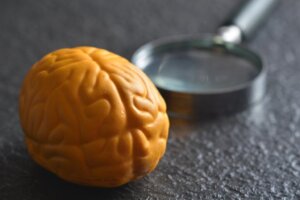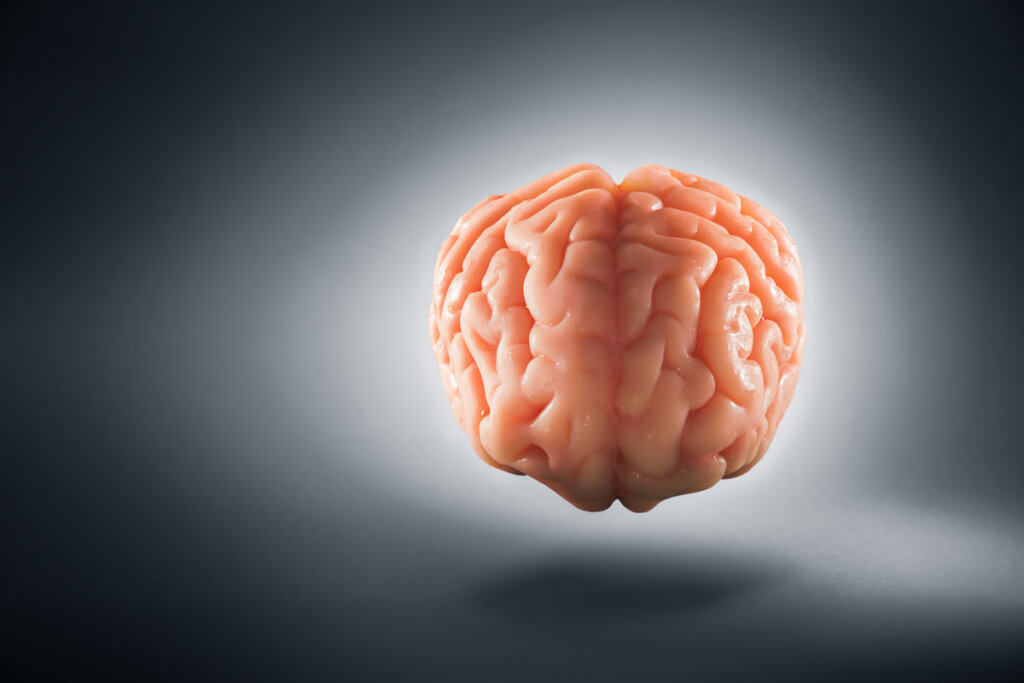Why Does The Brain Have Two Hemispheres?


Written and verified by the psychologist Valeria Sabater
It may seem like a simple and even childish question. However, why does the brain have two hemispheres? Is there any particular reason why its evolution meant that it didn’t form a unified and perfectly spherical organ? As a matter of fact, this question, far from being too simplistic, is of great interest to the scientific community.
For starters, there are many who, on seeing the shape of a brain, are intrigued by all those folds of the cerebral cortex. Indeed, this organ, far from being spherical and smooth, exhibits a surface full of bumps and folds. Furthermore, if we could extend it completely, we’d discover that it’d be the length of a small tablecloth: almost 2,500 square centimeters.
The reason for the folds and the bumpy shape is simple: it saves space. In fact, folding in on itself allows it to be denser and longer. This is already an evolutionary advantage. In addition, when it comes to its distribution and why it has two hemispheres, the answer follows along the same lines. It allows us to achieve greater specialization.
The brain is a highly sophisticated organ. Above all, it’s a specialized organ. In fact, every area fulfills a specific function. That’s why both the shape and the distribution of this organ are so decisive.
“I am a brain, Watson. The rest of me is a mere appendix.”
-Sherlock Holmes-

Why does the brain have two hemispheres?
One of the answers that may first come to mind with regards to why the brain has two hemispheres may be related to the idea of spherical dominance. However, this needs qualifying. In fact, for many years the theory was proposed that intuitive and creative people used the right hemisphere more while logical people used the left side more.
However, the brain dominance theory is a neuromyth. As a matter of fact, the human being uses both hemispheres equally. Nevertheless, to this day, this theory remains popular. It was introduced in the 1960s by neuropsychologist Roger Sperry. However, more recent studies such as the one carried out at the Andrés Bello Catholic University (Venezuela) show that there’s no evidence to support this claim.
Nevertheless, the brain did evolve in two halves. However, not to the extent that one-half was more skilled in some disciplines than others. Indeed, the classic folds and the two hemispheres are jointly responsible for the functions that this wonderful organ performs.
Brain division is extremely beneficial
Let’s think about a big closet. If you want it to be functional and practical, the first thing you do is to put shelves in it. That’s because it’ll be pretty useless if it’s simply a construction without any useful layout inside. It’s the same with the brain. Research, published in the journal Neuron, suggests the following:
- Having different brain areas taking care of each complex task makes it more efficient.
- The purpose of the brain is to perform infinite functions at the same time. For this, it needs each region to fulfill a goal and connect with the others.
- The brain has two hemispheres because in each of them multiple activities are located. All of them are very specific. For instance, one is in charge of language and facial recognition, while another is responsible for writing or understanding what the individual hears.
The key to intelligence is in the asymmetric organization
The brain has two hemispheres in order to be able to distribute its functions. It’s true that each region deals with very specific tasks. However, they’re not carried out independently. For this reason, we mustn’t fall into the trap of thinking that someone’s more creative because they use the right hemisphere more.
In reality, the processes that activate creativity and innovation use both sides. While one reflects, the other analyzes and compares. The right connects with your emotions and conscience, while the left allows you to write down your ideas, and evaluate them.
All of this contributes to enhancing your intelligence. Therefore, brain asymmetry favors your ability to adapt to any difficulties.

The brain has two hemispheres and not only in the human being
For a long time, the classic anthropocentric theories were quite important. We refer to those that assumed that certain neurological characteristics were only present in humans. However, many animals also show clear asymmetry and lateralization.
It was in the 70s when it was discovered that not only great primates had two hemispheres. As a matter of fact, many mammals, different types of birds, the ever-intelligent rats, worms, and even bees have this characteristic. The reason for this is simple too. It’s the fact that a specialized brain favors the survival of the species.
Brain asymmetry is key to your organization and specialization. Thus, a highly specialized brain is a more efficient brain that favors the animal’s ability to survive. What’s more, we even know that there are right-handed and left-handed animals. In fact, 90 percent of parrots are left-handed. They use their left claw to eat and interact.
Furthermore, there are types of tarantulas that have a preference for their right legs, while red kangaroos are also left-handed. However, to this day, we don’t know why.
It may seem like a simple and even childish question. However, why does the brain have two hemispheres? Is there any particular reason why its evolution meant that it didn’t form a unified and perfectly spherical organ? As a matter of fact, this question, far from being too simplistic, is of great interest to the scientific community.
For starters, there are many who, on seeing the shape of a brain, are intrigued by all those folds of the cerebral cortex. Indeed, this organ, far from being spherical and smooth, exhibits a surface full of bumps and folds. Furthermore, if we could extend it completely, we’d discover that it’d be the length of a small tablecloth: almost 2,500 square centimeters.
The reason for the folds and the bumpy shape is simple: it saves space. In fact, folding in on itself allows it to be denser and longer. This is already an evolutionary advantage. In addition, when it comes to its distribution and why it has two hemispheres, the answer follows along the same lines. It allows us to achieve greater specialization.
The brain is a highly sophisticated organ. Above all, it’s a specialized organ. In fact, every area fulfills a specific function. That’s why both the shape and the distribution of this organ are so decisive.
“I am a brain, Watson. The rest of me is a mere appendix.”
-Sherlock Holmes-

Why does the brain have two hemispheres?
One of the answers that may first come to mind with regards to why the brain has two hemispheres may be related to the idea of spherical dominance. However, this needs qualifying. In fact, for many years the theory was proposed that intuitive and creative people used the right hemisphere more while logical people used the left side more.
However, the brain dominance theory is a neuromyth. As a matter of fact, the human being uses both hemispheres equally. Nevertheless, to this day, this theory remains popular. It was introduced in the 1960s by neuropsychologist Roger Sperry. However, more recent studies such as the one carried out at the Andrés Bello Catholic University (Venezuela) show that there’s no evidence to support this claim.
Nevertheless, the brain did evolve in two halves. However, not to the extent that one-half was more skilled in some disciplines than others. Indeed, the classic folds and the two hemispheres are jointly responsible for the functions that this wonderful organ performs.
Brain division is extremely beneficial
Let’s think about a big closet. If you want it to be functional and practical, the first thing you do is to put shelves in it. That’s because it’ll be pretty useless if it’s simply a construction without any useful layout inside. It’s the same with the brain. Research, published in the journal Neuron, suggests the following:
- Having different brain areas taking care of each complex task makes it more efficient.
- The purpose of the brain is to perform infinite functions at the same time. For this, it needs each region to fulfill a goal and connect with the others.
- The brain has two hemispheres because in each of them multiple activities are located. All of them are very specific. For instance, one is in charge of language and facial recognition, while another is responsible for writing or understanding what the individual hears.
The key to intelligence is in the asymmetric organization
The brain has two hemispheres in order to be able to distribute its functions. It’s true that each region deals with very specific tasks. However, they’re not carried out independently. For this reason, we mustn’t fall into the trap of thinking that someone’s more creative because they use the right hemisphere more.
In reality, the processes that activate creativity and innovation use both sides. While one reflects, the other analyzes and compares. The right connects with your emotions and conscience, while the left allows you to write down your ideas, and evaluate them.
All of this contributes to enhancing your intelligence. Therefore, brain asymmetry favors your ability to adapt to any difficulties.

The brain has two hemispheres and not only in the human being
For a long time, the classic anthropocentric theories were quite important. We refer to those that assumed that certain neurological characteristics were only present in humans. However, many animals also show clear asymmetry and lateralization.
It was in the 70s when it was discovered that not only great primates had two hemispheres. As a matter of fact, many mammals, different types of birds, the ever-intelligent rats, worms, and even bees have this characteristic. The reason for this is simple too. It’s the fact that a specialized brain favors the survival of the species.
Brain asymmetry is key to your organization and specialization. Thus, a highly specialized brain is a more efficient brain that favors the animal’s ability to survive. What’s more, we even know that there are right-handed and left-handed animals. In fact, 90 percent of parrots are left-handed. They use their left claw to eat and interact.
Furthermore, there are types of tarantulas that have a preference for their right legs, while red kangaroos are also left-handed. However, to this day, we don’t know why.
All cited sources were thoroughly reviewed by our team to ensure their quality, reliability, currency, and validity. The bibliography of this article was considered reliable and of academic or scientific accuracy.
- Carvajal, Rubén. (2018). Mitos y realidades sobre lateralidad y dominancia hemisférica: implicaciones en educación..
- Walsh V. Hemispheric asymmetries: a brain in two minds. Curr Biol. 2000 Jun 15;10(12):R460-2. doi: 10.1016/s0960-9822(00)00533-9. PMID: 10873796.
This text is provided for informational purposes only and does not replace consultation with a professional. If in doubt, consult your specialist.







